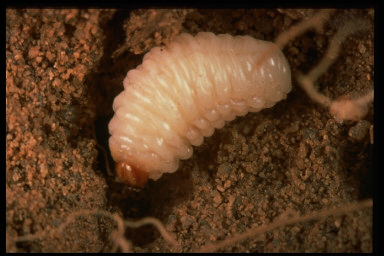Sunflower Insects
The sunflower root weevil, Baris strenua (Coleoptera: Curculionidae)

Adult Baris strenua

Sunflower root weevil grub.
Identification
This is a, glossy black weevil 5.0 – 8.0 mm (1/4 - 1/2 inch) in length with a short, downward-curving snout. Adults can often be seen on the surfaces of sunflower foliage in spring and quickly tumble to the ground when approached. The eggs are bright yellow and are typically deposited in groups of 2 or 3 in the callous tissue that develops around adult feeding scars in the region of the root crown. The larvae hatch in mid-summer and quickly become large, plump, white grubs that can often be found by sifting through the soil around up-rooted sunflower plants. A series of up-rooted plants is often an indication that badgers or other small mammals are systematically foraging for root weevil larvae in a sunflower field.
Life History and Behavior
There is one generation per year, the adults emerging in early spring to feed on sunflower foliage. They do little damage, but eventually descend to the root crown where the females lay their eggs. The larvae develop as free-living insects in the soil feeding on root tissues and overwinter in earthen cells they construct near the decaying roots. When larvae are exceptionally abundant, they may cause plant wilting and lodging, but no economic thresholds have been established. However, the sunflower root weevil is often the indirect cause of crop losses because its plump larvae are a food source highly prized by skunks and badgers that can do substantial damage by uprooting many plants in their search for them.
Management
There are no management recommendations for sunflower root weevil. However, growers should realize that significant burrowing in sunflower fields and numerous uprooted plants are often caused by mammals foraging for root weevil larvae.
Page last updated 10/03/2013 by J.P. Michaud.